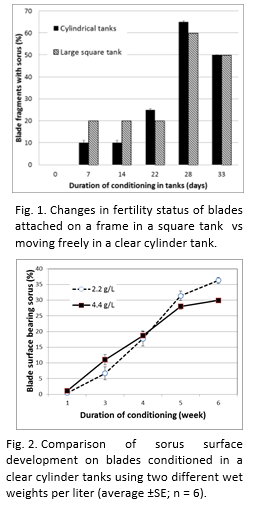SCALING UP THE ARTIFICIAL INDUCTION OF SPOROGENESIS IN Saccharina latissima
Saccharina latissima is gaining economic importance as an aquaculture crop. In eastern Canada, seeding of the culture ropes occurs at a time of the year when access to ripe kelp blades is not guaranteed because of heavy biofouling by bryozoans. A marine hatchery planned exploring the artificial induction of sorus and a series of experiments were set up to examine how to save floor space and maximise the sorus produced per tank using existing equipment. The meristem and outer wings of all fronds were discarded. Some blades were attached on a horizontal net support in a large square tank. In other fronds, the central part of the blades was cutted into short fragments which were immerged in various types of tanks with flowing seawater and aeration to keep them moving. Water temperature was controlled and white light illumination was adjusted to provide a constant short day of 8 h with an intensity of 100 µmol m-2 s-1. In the various set-up tested, the first sorus appeared at the end of the first week and ≥50 % of the blade fragments were fertile after 28 days, whether tied on a net or moving freely in the tanks (Fig. 1). Regarding the effect of blade wet biomass in clear cylindrical tanks, it was observed that 100% of the fragments were fertile after 45 days, with 36% and 30% of the fragments surface area as dark sorus, respectively in the 2.2 g L-1 and 4.4 g L-1 treatments (Fig. 2). The same results were obtained when using the plastic bags for microalgal culture provided by the hatchery. The experiments showed that conditioning blades fragments moving freely in a raised cylindrical tank is as effective as intact blades tied on a frame in a square tank, which means significant floor space saving for kelp hatcheries. Less biofouling was observed when using the medium part of the blades at 4.4 g L-1. Since some fragments were maturing faster, some culture twines could be seeded with spores at the 4th week and some at the 6th week. With this set up, one 250 L cylindrical tank produce enough sorus to seed 29 m of a 1.5 mm diam. twine if a concentration of 7 500 spores ml-1 is used in the seeding tank.
